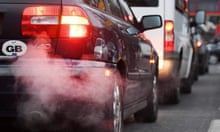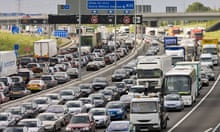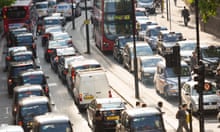Hundreds of thousands of children are being exposed to illegal levels of damaging air pollution from diesel vehicles at schools and nurseries across England and Wales, a joint investigation by the Guardian and Greenpeace’s investigations unit has revealed.
The analysis of the most recent government data exposes how dangerous levels of nitrogen dioxide (NO2) pollution from diesel traffic are not limited to large metropolitan centres, but threaten the health of children and young people in towns and cities from Newcastle to Plymouth.
The research shows more than 1,000 nurseries which look after 47,000 babies and children are in close proximity to roads where the level of nitrogen dioxide from diesel traffic exceeds the legal limit of 40µg/m3 (micrograms per cubic metre of air).
The findings come as the government is under pressure to dramatically improve its strategy to clean up the nation’s air, after the high court said its plans to reduce illegal levels of harmful emissions were so poor as to be unlawful. Ministers have to produce new draft measures to tackle air pollution by 24 April.
Chris Griffiths, professor of primary care and public health at Bart’s and the London School of Medicine, said the findings were very important and called for a dramatic change in attitudes within society and from government.
“The research on exposure to traffic fumes and children’s lung growth is pretty consistent. It shows that such exposure reduces lung growth, produces long term ill health and can cause premature death. We should be outraged that we are exposing our developing children to these obvious problems.”
Griffiths said while 40µg/m3 was the legal limit in Europe, there was no safe level of exposure to diesel fumes and that areas which did not show up in the analysis could not be complacent.
“Why should we tolerate this?” said Griffiths. “It is a relatively simple thing to try and solve. It is a choice we have to make. Rather than telling people to take their inhaler, stay indoors and reduce exercise when there are high pollution levels, attitudes need to change and we need to make the polluter pay.”
The investigation used the government’s own pollution modelling from 2015 to identify all schools and nurseries – whether private, academy or state maintained – which are within 150 metres of a road where emissions of NO2 are above the legal limit. Figures for Wales do not include private nurseries.
It found:
- 2,091 schools, nurseries, further education centres and after school clubs are within 150 metres of a road emitting illegal levels of nitrogen dioxide.
- There are 1,013 nurseries looking after children from six months to five years old within 150m of illegal NO2 levels.
- Five of the 10 areas with the worst exposed nurseries outside London were in the West Midlands.
- Towns as far afield as Plymouth, Poole and Hull all had nurseries and schools in areas above legal NO2 limits.
- 15 London boroughs had at least a quarter of nurseries in an illegal N02 hotspot
- The highest pollution pocket of 118.19µg/m3 – almost three times the legal limit – was at a nursery in Tower Hamlets, east London.
The scale of the exposure of young children to dangerous diesel emissions is likely to be an underestimate as it is based on government modelling which has been criticised by judges as overly optimistic. Ministers will have to come up with more sensitive analysis in their draft air quality plan this month which is likely to reveal that many more children are being exposed to dirty air from diesel traffic.
Anna Jones, clean air campaigner at Greenpeace, said there was a need to raise awareness around the country about dangerous levels of nitrogen dioxide air pollution. She called for urgent government action with car companies to get polluting vehicles off the streets.
“Most people don’t realise that all across the country toddlers are being exposed to invisible air pollution caused by diesel vehicles,” said Jones.
“We were told diesel vehicles were the cleaner choice but car makers lied about the toxic pollution they emit. The only way to make our communities safer is to tackle air pollution head on. To fix this problem we need wholesale transformation on our roads away from diesel towards hybrid and electric vehicles. Both the government and the car companies need to work urgently to fix this.”
Birmingham was the worst area outside London for children’s exposure to diesel traffic fumes; 38 nurseries and 30 schools in the city are within 150m of a road where emissions of nitrogen dioxide exceed the legal limit.
But the analysis shows smaller towns and cities – including Poole and Oxford – also suffer diesel traffic pollution problems. In the south-west coastal city of Plymouth nearly 10% of nurseries are within 150m of illegal levels of NO2 emissions from roads.
In Nottingham 11% of nurseries are within 150m of an illegally polluting road. The school in the highest pollution pocket outside London is Widnes Academy primary school in the north-west, and the pottery town of Stoke on Trent has five nurseries and four schools close to damaging levels of air pollution.
Andy Burnham, Labour’s candidate for mayor of Greater Manchester, where 20 nurseries, schools and after school clubs are close to dangerous levels of NO2 emissions, said he has visited one school where pollution levels are almost three times the legal limit. “I have urged the government to give the mayor of Greater Manchester powers to introduce a clean air zone so we can protect children and those most vulnerable from the high polluting vehicles. We also need a broader plan to reduce congestion, increase cycling and make public transport a clean, reliable and affordable alternative to the car.”
Some nursery providers and headteachers had no idea their schools were in pollution hotspots.
Sandra Nelson, manager of Step by Step Nursery in Bridge Avenue, Hammersmith, where road emissions levels are 107.47µg/m3 said: “It’s never been brought to my attention. If the level here is higher than what it should be I think it needs to be addressed by the local authority and the government.”
Marg Randles, managing director of Busy Bees Childcare, which has eight nurseries close to illegally polluting roads, said she supported attempts to improve UK air quality.
“Air quality is a concern for many communities in the UK. Undoubtedly the levels of pollution across many parts of the country have reached unacceptable levels and we understand that everyone is affected by high levels of nitrogen dioxide. Reducing the levels of pollution especially around homes, schools, hospitals and nurseries where levels are high is hugely important.”
Nitrogen dioxide emissions from diesel traffic cause 23,500 of the 40,000 premature deaths from air pollution each year, according to figures from the Department for Environment, Food and Rural Affairs. In April last year MPs said air pollution was a public health emergency.
A government spokesperson said: “We are firmly committed to improving the UK’s air quality and cutting harmful emissions. That’s why we have committed more than £2bn since 2011 to increase the uptake of ultra-low emissions vehicles, support greener transport schemes and set out how we will improve air quality through a new programme of Clean Air Zones.
“In addition, in the autumn statement, we announced a further £290m to support electric vehicles, low emission buses and taxis, and alternative fuels. We will update our air quality plans shortly to further improve the nation’s air quality.”










Comments (…)
Sign in or create your Guardian account to join the discussion